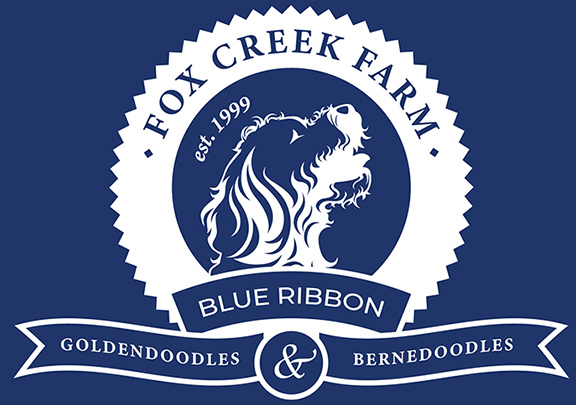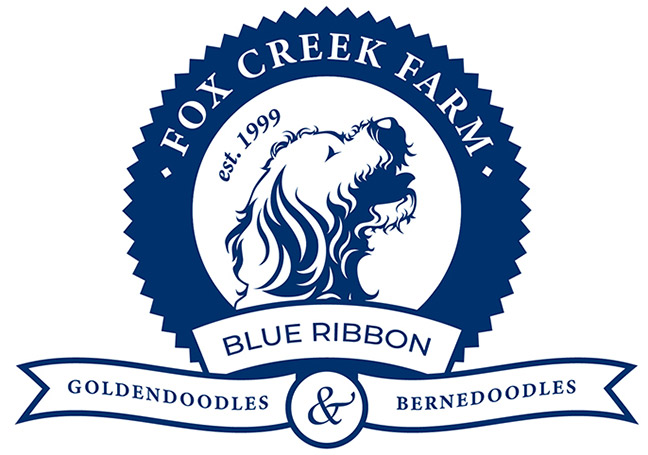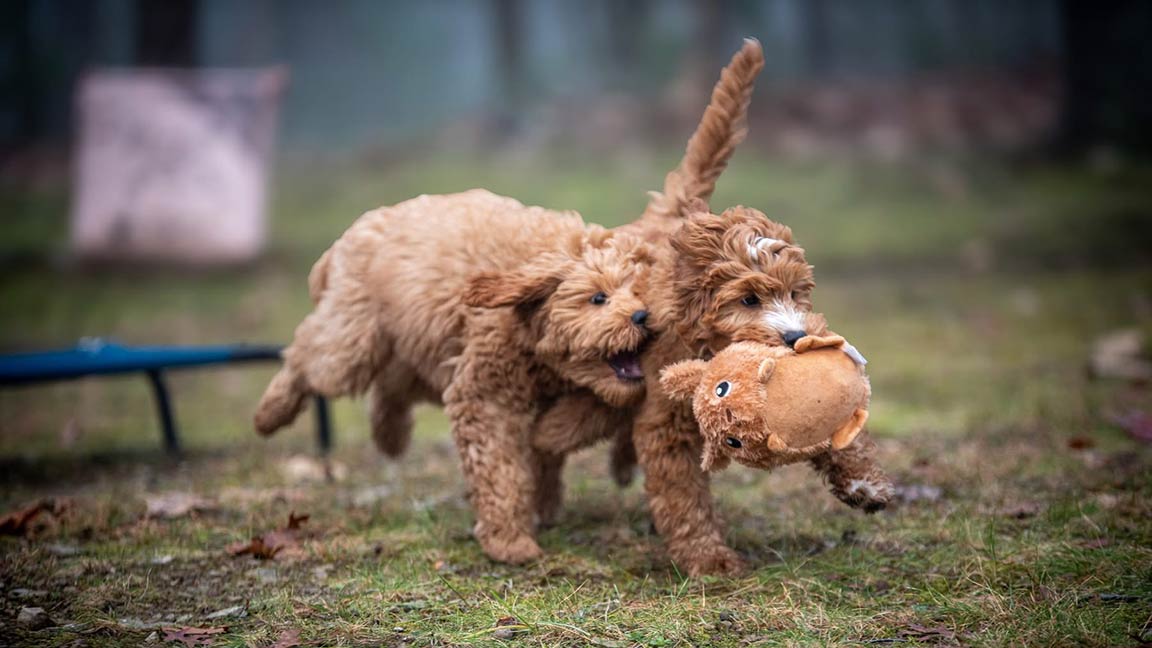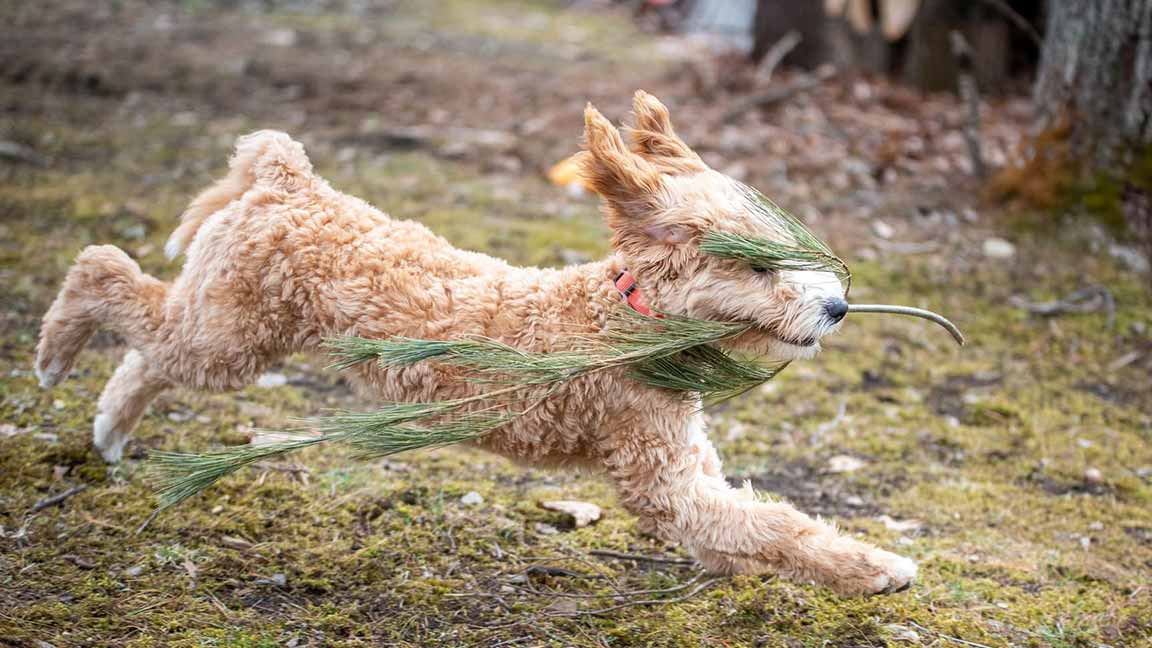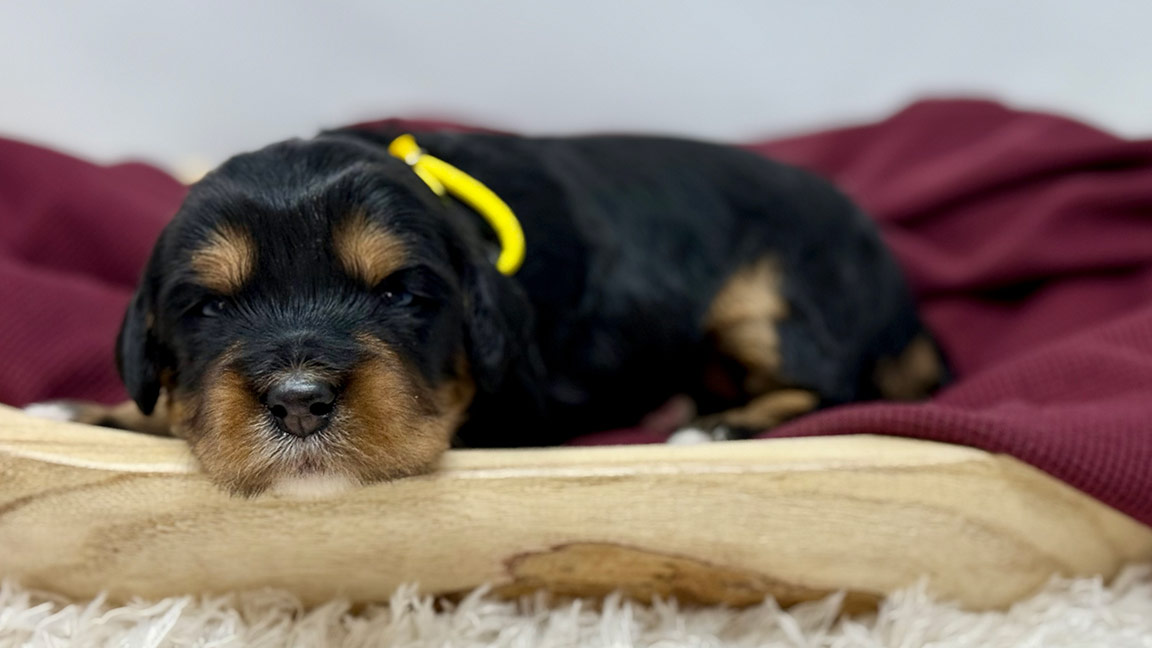
Bernedoodle Grooming: Tips to Keep Your Dog Looking Great
Understanding the Bernedoodle Coat
Bernedoodles are a mix of two breeds with very different coats—the Bernese Mountain Dog and the Poodle. This combination means that their coats can vary quite a bit, and understanding your dog’s coat type is essential for Bernedoodle grooming. Generally, Bernedoodles can have three main types of coats:
- Straight Coat: This coat type occurs when no curl genes are inherited and is only possible in a multigen litter. It is easier to maintain, but regular brushing is still required.
- Wavy Coat: This is the most common type and is a mix between the Bernese and Poodle coats. Wavy coats occur when a single curl gene is inherited. All F1’s have one curl gene and a wavy coat. This coat type needs consistent grooming to avoid tangling and matting.
- Curly Coat: Most similar to a Poodle’s coat, a curly coat occurs when two curl genes pair in a puppy. It is also the most maintenance-intensive and prone to matting if not brushed frequently.
It’s crucial to recognize your Bernedoodle’s coat type, as it will determine how often you’ll need to groom them and what kind of grooming tools you’ll need. The great news is that no matter what type of coat your Bernedoodle has, with proper Bernedoodle grooming care, their fur will stay healthy, soft, and beautiful.
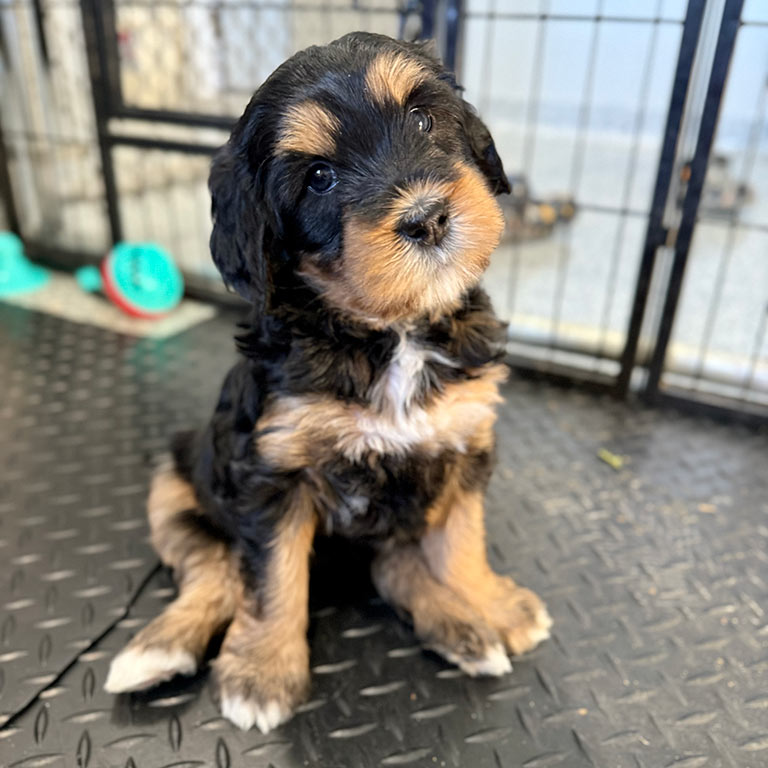 Why Regular Bernedoodle Grooming is Essential
Why Regular Bernedoodle Grooming is Essential
Many people assume that grooming is simply about making their dog look good, but it goes much deeper than aesthetics. Regular grooming is a vital part of keeping your Bernedoodle healthy and comfortable. Let’s dive into some of the reasons why maintaining a grooming routine is so important:
- Matting Prevention: Matting is one of the biggest concerns for Bernedoodle owners, especially for those with curly or wavy coats. Mats are tight tangles in the fur that can cause discomfort, skin irritation, and even infections if left unattended. Regular grooming helps keep these mats at bay.
- Comfort: A clean, well-groomed coat allows your dog to stay comfortable. Dirt, debris, and loose fur can make your dog itchy or uncomfortable. Brushing removes these irritants and helps regulate your dog’s temperature, especially in warmer weather.
- Shedding Control: While Bernedoodles are often touted as low-shedding dogs, they can still shed, especially if they inherited just one furnishing gene. Regular grooming helps manage shedding and keeps the hair off your furniture and clothes.
- Health Monitoring: Grooming time is an opportunity to check your dog for any issues like skin irritations, lumps, or fleas. By regularly running your hands through their fur and skin, you can spot problems early and address them promptly.
At Fox Creek Farm, we understand the importance of regular grooming. Our Bernedoodles are known for their stunning coats, and with proper care, they stay healthy and look their best.
Brushing Your Bernedoodle’s Coat
Brushing is the cornerstone of Bernedoodle grooming. Whether your dog has a straight, wavy, or curly coat, brushing is essential to prevent matting, reduce shedding, and keep their coat soft and shiny. Here’s how you can make brushing a positive experience for both you and your dog:
- Frequency: The frequency of brushing depends on the coat type. For Bernedoodles with curly coats, brushing daily or every other day is best to prevent matting. For those with wavy or straight coats, brushing two to three times a week should suffice.
- Tools: Using the right tools makes a world of difference. A slicker brush works well for curly coats, while a pin brush is effective for wavy or straight coats. For tangled spots or small mats, a metal comb can help break them up gently.
- Technique: When brushing, always start at the tips of the hair and gradually work your way toward the base, near the skin. This helps avoid tugging on knots, which can be painful for your dog. Be patient and gentle, especially when working through mats or knots.
Brushing should always be a pleasant experience for your dog. Start slow and make it part of your routine so they become accustomed to it. Treats and positive reinforcement can help turn grooming sessions into bonding time.
 Bathing Your Bernedoodle
Bathing Your Bernedoodle
Bathing is another crucial part of Bernedoodle grooming. However, it’s important not to overdo it, as frequent baths can strip their coat of natural oils, leaving the skin dry and irritated. Typically, a bath every 3 to 6 weeks is ideal, depending on your dog’s activity level and coat type.
When it’s time for a bath, use a gentle dog shampoo specifically designed for sensitive skin. Bernedoodles, especially those with curly coats, can be prone to skin issues if harsh chemicals are used. Be sure to thoroughly wet the coat before applying shampoo, as Bernedoodles’ dense fur can sometimes resist water at first. Gently lather the shampoo into the coat, paying close attention to problem areas like the paws, belly, and under the ears where dirt and grime tend to accumulate.
After rinsing out all of the shampoo, apply a moisturizing conditioner to help keep the coat soft and reduce tangles. Let it sit for a couple of minutes before rinsing thoroughly. Proper rinsing is essential because leftover shampoo or conditioner can irritate the skin.
Once bath time is over, gently towel-dry your Bernedoodle and, if necessary, use a blow dryer on a cool setting to dry their coat completely. Be sure to brush through the fur after drying to prevent mats from forming while the coat is still damp.
Bathing may not be your dog’s favorite activity, but making it a calm and positive experience, with lots of praise and treats, can help ease their discomfort over time.
Nail Trimming and Ear Cleaning
Nail trimming and ear cleaning are often overlooked in a Bernedoodle grooming routine, but both are essential for your Bernedoodle’s health. Long nails can cause discomfort, affect how your dog walks, and even lead to injury. Depending on how active your dog is, their nails may wear down naturally, but most Bernedoodles will still need a trim every few weeks.
To trim your dog’s nails, use a high-quality dog nail clipper and be cautious not to cut too close to the quick, the sensitive area inside the nail that can bleed if nicked. If you’re unsure, take it slow and trim small amounts at a time, or seek professional help from a groomer. Over time, regular trimming will keep the quick receded, making it easier to manage the length of your dog’s nails.
Ear cleaning is equally important, especially since Bernedoodles have floppy ears. Moisture and dirt can easily get trapped in the ear canal, leading to infections. Clean your dog’s ears weekly using a holistic or veterinarian-approved ear cleaner and cotton balls. Gently wipe the outer part of the ear, being careful not to push anything too far into the ear canal. If you notice any redness, bad odor, or excess wax buildup, it may be time to consult your vet.
Routine care for your dog’s nails and ears will help prevent discomfort and potential health issues down the line. These are small tasks that make a big difference in your Bernedoodle’s overall well-being.
Maintaining a Healthy Skin and Coat
The health of your Bernedoodle’s skin and coat is directly tied to their overall grooming routine, but it also relies on other factors like diet and exercise. A balanced diet rich in omega-3 and omega-6 fatty acids can support healthy skin and a shiny coat. High-quality dog food or supplements specifically designed for skin and coat health are great additions to your dog’s diet.
Regular exercise is also crucial. Not only does it keep your dog in good physical condition, but it also supports healthy circulation, which is vital for skin and coat health. A well-exercised Bernedoodle is more likely to have a vibrant, shiny coat due to improved blood flow.
Hydration plays a role as well. Make sure your dog has access to fresh, clean water at all times, as dehydration can lead to dry, flaky skin and a dull coat. Keep an eye on their hydration, especially during warmer months or after vigorous play sessions.
Incorporating regular Bernedoodle grooming, a balanced diet, and plenty of physical activity into your Bernedoodle’s routine will help maintain a healthy, shiny coat that is soft to the touch.
 BernedoodleGrooming Tools Every Owner Needs
BernedoodleGrooming Tools Every Owner Needs
Having the right tools can make all the difference for Bernedoodle grooming. Investing in high-quality tools not only makes the process easier but also ensures that your dog’s coat is properly cared for. Here are the essential Bernedoodle grooming tools every owner should have:
- Slicker Brush: Ideal for removing tangles and mats, especially for curly-coated Bernedoodles. This brush helps reach the undercoat and prevents matting.
- Pin Brush: Great for wavy and straight coats, a pin brush helps distribute natural oils through the fur, leaving the coat shiny and smooth.
- Metal Comb: This is especially useful for areas prone to matting, like behind the ears and under the legs. It’s perfect for getting out small tangles without hurting your dog.
- Dog Nail Clippers: Keep your dog’s nails at a healthy length with a sturdy pair of clippers. Alternatively, a nail grinder can be used for a smoother finish.
- Shampoo and Conditioner: Use high-quality, gentle dog shampoo and conditioner specifically formulated for sensitive skin. This helps maintain a healthy coat while preventing skin irritation.
- Ear Cleaner: A good ear cleaner will help keep your dog’s ears free of debris and reduce the risk of infections.
Having these tools on hand and using them regularly will keep your Bernedoodle looking their best and feeling comfortable.
Professional Bernedoodle Grooming: When and Why
While regular at-home grooming is essential, professional grooming is still necessary to keep your Bernedoodle’s coat in top shape. Depending on your dog’s coat type and how fast their hair grows, professional grooming is recommended every 6 to 8 weeks.
A professional groomer will be able to give your dog a thorough cleaning, trim their coat to the perfect length, and ensure there are no mats or tangles left behind. Professional groomers also have the expertise and tools to manage difficult areas, such as cutting around the eyes, trimming paw pads, and expressing anal glands if needed.
If you’re unsure how to give your Bernedoodle a full groom at home, starting with professional grooming can help. They can also offer tips and guidance on how to maintain your dog’s coat between visits.
At Fox Creek Farm, we ensure that our puppies are accustomed to being handled from a young age, which makes professional grooming a stress-free experience for them as they grow.
Bernedoodle Grooming Tips for a Puppy
Grooming a Bernedoodle puppy requires a bit more patience, but starting early helps establish good habits for life. Puppies have softer, fluffier coats that are less prone to matting, but it’s important to introduce them to brushing, bathing, and nail trimming at a young age.
When grooming your puppy, keep sessions short and positive. Use treats and lots of praise to make the experience enjoyable. Let your puppy get used to the sound of the blow dryer, the feel of the brush, and even handling their paws for nail trims. Early exposure to grooming tools and routines will help your puppy develop a lifelong comfort with the grooming process.
Puppies from Fox Creek Farm are gently introduced to grooming early on, making it easier for new owners to continue grooming them as they grow.
Final Thoughts on Bernedoodle Grooming
Grooming your Bernedoodle is a vital part of ensuring they stay healthy, happy, and looking their best. Whether you have a straight, wavy, or curly-coated Bernedoodle, a consistent grooming routine that includes regular brushing, bathing, nail trimming, and ear cleaning will keep your dog comfortable and well-groomed. Don’t forget to invest in the right grooming tools and, when necessary, rely on professional grooming to maintain your dog’s coat.
At Fox Creek Farm, we take pride in producing some of the best Bernedoodles around, with gorgeous coats that reflect the care and attention they receive. By following these grooming tips, you can ensure your Bernedoodle continues to look and feel great.

FAQ: Bernedoodle Grooming
Q: How often should I groom my Bernedoodle?
A: Bernedoodles should be brushed several times a week, depending on their coat type. Curly-coated Bernedoodles may need daily brushing to prevent mats, while wavy or straight coats may only require brushing two to three times per week. Bathing is recommended every 3 to 6 weeks, and professional grooming should be done every 6 to 8 weeks.
Q: What grooming tools are best for Bernedoodles?
A: Essential tools for Bernedoodle grooming include a slicker brush for curly coats, a pin brush for wavy or straight coats, a metal comb for tangles, dog nail clippers or a grinder, and a gentle dog shampoo and conditioner. It’s also important to have ear-cleaning supplies for regular ear care.
Q: How can I prevent my Bernedoodle’s coat from matting?
A: Regular brushing is key to preventing mats. Make sure to brush thoroughly, focusing on areas prone to tangling, like behind the ears, under the legs, and around the collar. Use a slicker brush and a metal comb to work through any small mats before they become larger and more difficult to remove.
Q: Should I take my Bernedoodle to a professional groomer?
A: Yes, while regular at-home grooming is essential, professional grooming every 6 to 8 weeks is recommended. Groomers have the expertise to trim your dog’s coat, manage difficult areas, and ensure they stay mat-free and well-maintained.
Q: How often should I trim my Bernedoodle’s nails?
A: Nail trimming should be done every few weeks, depending on how fast your Bernedoodle’s nails grow. Regular trimming prevents discomfort and potential injuries, especially for active dogs.
Q: How do I clean my Bernedoodle’s ears?
A: To clean your Bernedoodle’s ears, use a holistic or vet-approved ear cleaner and cotton balls. Gently wipe the outer ear and avoid pushing anything deep into the ear canal. Weekly ear cleaning can help prevent infections, particularly in Bernedoodles with floppy ears, where moisture and debris can get trapped.
Q: Can I groom my Bernedoodle puppy the same way I would an adult?
A: Yes, but keep grooming sessions short and positive when working with puppies. Use treats and praise to get them comfortable with brushing, bathing, and nail trimming. Starting early helps establish good grooming habits and ensures your puppy grows up comfortable with the process.
Q: How can I make grooming a positive experience for my Bernedoodle?
A: Start grooming early and keep sessions positive with treats and praise. Make the experience calm and gentle, avoiding any forceful actions. Gradually introduce your Bernedoodle to the sounds and sensations of grooming tools, such as blow dryers and nail clippers, to reduce fear or anxiety.
